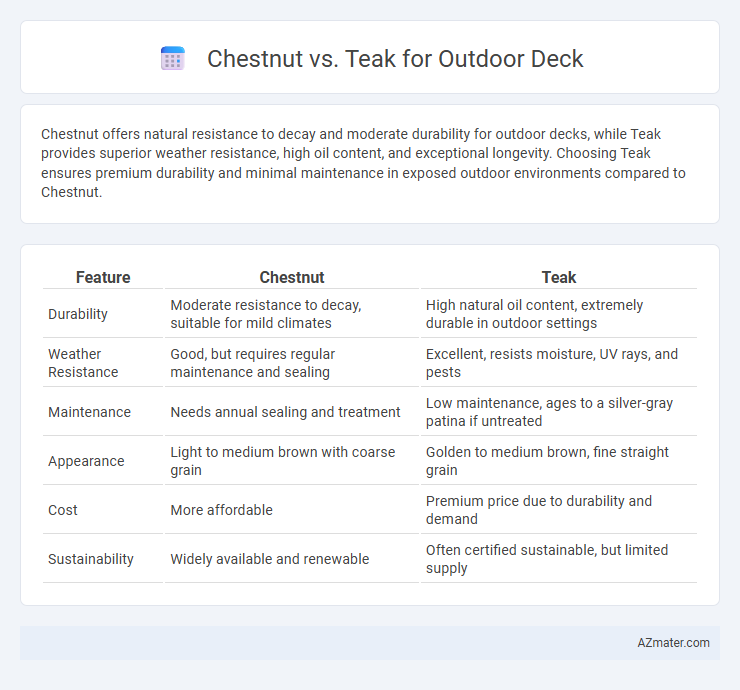Chestnut offers natural resistance to decay and moderate durability for outdoor decks, while Teak provides superior weather resistance, high oil content, and exceptional longevity. Choosing Teak ensures premium durability and minimal maintenance in exposed outdoor environments compared to Chestnut.
Table of Comparison
| Feature | Chestnut | Teak |
|---|---|---|
| Durability | Moderate resistance to decay, suitable for mild climates | High natural oil content, extremely durable in outdoor settings |
| Weather Resistance | Good, but requires regular maintenance and sealing | Excellent, resists moisture, UV rays, and pests |
| Maintenance | Needs annual sealing and treatment | Low maintenance, ages to a silver-gray patina if untreated |
| Appearance | Light to medium brown with coarse grain | Golden to medium brown, fine straight grain |
| Cost | More affordable | Premium price due to durability and demand |
| Sustainability | Widely available and renewable | Often certified sustainable, but limited supply |
Introduction to Chestnut and Teak for Outdoor Decks
Chestnut wood, known for its durability and natural resistance to decay, offers a warm, reddish-brown hue ideal for outdoor decks requiring longevity and aesthetic appeal. Teak is prized for its high oil content, making it exceptionally resistant to water, insects, and rot, which ensures a long-lasting, low-maintenance outdoor deck with a golden-brown color that weathers gracefully over time. Both Chestnut and Teak provide strong, dense hardwood options, but Teak's superior weather resistance and natural oils make it a premium choice for high-exposure outdoor decking.
Wood Characteristics: Chestnut vs Teak
Chestnut offers a moderately dense wood with a Janka hardness of about 540, making it durable but less resistant to heavy impact than teak, which has a Janka hardness around 1,155. Teak wood is naturally oil-rich, providing superior water resistance and protection against decay, while chestnut requires sealing to enhance its weather durability. The lighter, straighter grain of chestnut contrasts with teak's tighter, richer golden-brown hue that deepens over time, making teak preferred for high-end outdoor decking due to its longevity and minimal maintenance.
Durability and Weather Resistance Comparison
Chestnut offers moderate durability and good weather resistance, making it suitable for outdoor decks in milder climates where prolonged exposure to moisture and insects is less intense. Teak is renowned for its exceptional durability and superior weather resistance due to natural oils that protect against rot, insects, and extreme weather, making it ideal for harsh outdoor environments. When comparing chestnut vs teak for outdoor decks, teak provides a longer lifespan and requires less maintenance under severe weather conditions, though it typically comes at a higher cost.
Maintenance Requirements for Chestnut and Teak Decks
Chestnut decks require regular sealing and staining to protect against moisture and UV damage, with maintenance needed every 1-2 years to prevent cracking and warping. Teak decks naturally resist rot and insect damage due to high oil content, requiring minimal upkeep beyond occasional cleaning and periodic application of teak oil to maintain its rich color. Both woods benefit from proper drainage and cleaning to extend their lifespan, but teak offers a longer-lasting, lower-maintenance option for outdoor decking.
Aesthetic Appeal: Color and Grain Differences
Chestnut offers a warm, reddish-brown hue with a fine, straight grain that deepens beautifully over time, creating a rustic yet elegant look for outdoor decks. Teak boasts a rich golden-brown color that weathers to a sophisticated silvery-gray patina, with a more pronounced, wavy grain pattern that adds dynamic texture and visual interest. The color stability and distinctive grain of teak make it a popular choice for high-end decking, while chestnut's natural warmth and subtle grain variations provide a timeless appeal for rustic or traditional outdoor spaces.
Cost Analysis: Chestnut vs Teak
Chestnut offers a more budget-friendly option for outdoor decking, with prices typically ranging from $4 to $8 per square foot, compared to teak, which can cost between $15 and $30 per square foot due to its premium durability and natural oil content. While teak demands a higher initial investment, its resistance to rot, insects, and weather reduces maintenance costs over time, potentially offsetting the upfront expense. Chestnut, though less costly initially, may require more frequent sealing and repairs, impacting long-term maintenance budgets.
Environmental Impact and Sustainability
Chestnut offers a more sustainable option for outdoor decking due to its rapid growth rates and natural resistance to decay, reducing the need for chemical treatments. Teak, while highly durable and resistant to weather, often comes from slow-growing trees in tropical forests, raising concerns about deforestation and habitat loss when not sourced sustainably. Choosing FSC-certified chestnut or teak ensures responsible forestry practices and minimizes environmental impact in outdoor deck construction.
Installation Ease and Compatibility
Chestnut offers moderate installation ease due to its stable density and natural resistance to splitting, making it compatible with common decking fasteners and tools. Teak's dense grain and high oil content can complicate installation, requiring pre-drilling and specialized corrosion-resistant fasteners for secure assembly. Both woods are compatible with standard decking joist spacing, but chestnut generally allows faster installation with less specialized equipment.
Longevity and Performance Over Time
Chestnut offers moderate durability for outdoor decks, typically lasting 15 to 25 years with proper maintenance due to its natural resistance to decay and insects. Teak excels in longevity and performance, often exceeding 40 years, thanks to its high natural oil content that makes it highly resistant to weather, rot, and pests. While teak demands less upkeep, chestnut requires regular sealing and treatment to maintain its structural integrity and appearance over time.
Choosing the Best Wood for Your Outdoor Deck
Chestnut and teak are both excellent options for outdoor decking, but teak offers superior durability and natural resistance to weather and pests due to its high oil content. Chestnut provides a more affordable alternative with a warm aesthetic, though it requires regular maintenance to prevent rot and decay. For long-lasting, low-maintenance decks, teak stands out as the best choice, especially in harsh climates where its strength and moisture resistance are crucial.

Infographic: Chestnut vs Teak for Outdoor Deck
 azmater.com
azmater.com